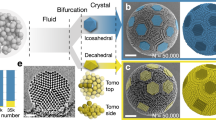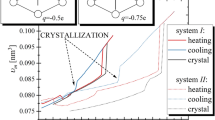Abstract
Crystal nucleation is a much-studied phenomenon, yet the rate at which it occurs remains difficult to predict. Small crystal nuclei form spontaneously in supersaturated solutions, but unless their size exceeds a critical value—the so-called critical nucleus—they will re-dissolve rather than grow. It is this rate-limiting step that has proved difficult to probe experimentally. The crystal nucleation rate depends on Pcrit, the (very small) probability that a critical nucleus forms spontaneously, and on a kinetic factor (κ) that measures the rate at which critical nuclei subsequently grow. Given the absence of a priori knowledge of either quantity, classical nucleation theory1 is commonly used to analyse crystal nucleation experiments, with the unconstrained parameters adjusted to fit the observations. This approach yields no ‘first principles’ prediction of absolute nucleation rates. Here we approach the problem from a different angle, simulating the nucleation process in a suspension of hard colloidal spheres, to obtain quantitative numerical predictions of the crystal nucleation rate. We find large discrepancies between the computed nucleation rates and those deduced from experiments2,3,4: the best experimental estimates of Pcrit seem to be too large by several orders of magnitude.
This is a preview of subscription content, access via your institution
Access options
Subscribe to this journal
Receive 51 print issues and online access
$199.00 per year
only $3.90 per issue
Buy this article
- Purchase on Springer Link
- Instant access to full article PDF
Prices may be subject to local taxes which are calculated during checkout




Similar content being viewed by others
References
Kelton, K. F. Solid State Physics Vol. 45, 75–90 (Academic, New York, 1991).
Schätzel, K. & Ackerson, B. J. Density fluctuations during crystallization of colloids. Phys. Rev. E 48, 3766–3777 (1993).
Harland, J. L. & Van Megen, W. Crystallization kinetics of suspensions of hard colloidal spheres. Phys. Rev. E 55, 3054–3067 (1997).
Cheng, Z. Colloidal Hard Sphere Crystallization and Glass Transition. Thesis, Princeton Univ. (1998).
Zhu, J. et al. Crystallization of hard-sphere colloids under microgravity. Nature 387, 883–885 (1997).
Van Duijneveldt, J. S. & Lekkerkerker, H. N. W. in Science and Technology of Crystal Growth (eds van der Eerden, J. P. & Bruinsma, O. S. L.) 279–290 (Kluwer Academic, Dordrecht, 1995).
Van Duijneveldt, J. S. & Frenkel, D. Computer simulation study of free energy barriers in crystal nucleation. J. Chem. Phys. 96, 4655–4668 (1992).
Ten Wolde, P. R., Ruiz-Montero, M. J. & Frenkel, D. Numerical evidence for b.c.c. or ordering at the surface of a critical f.c.c. nucleus. Phys. Rev. Lett. 75, 2714–2717 (1995).
Hoover, W. G. & Ree, F. H. Melting transition and communal entropy for hard spheres. J. Chem. Phys. 49, 3609–3617 (1968).
Hall, K. R. Another hard-sphere equation of state. J. Chem. Phys. 57, 2252–2254 (1970).
Davidchack, R. L. & Laird, B. B. Direct calculation of the hard-sphere crystal/melt interfacial free energy. Phys. Rev. Lett. 85, 4751–4754 (2000).
Hinsen, K. & Cichocki, B. Dynamic computer simulation of concentrated hard-sphere suspensions. Physica A 166, 473–491 (1990).
Medina-Noyola, M. Long-time self-diffusion in concentrated colloidal dispersions. Phys. Rev. Lett. 60, 2705–2708 (1988).
Ostwald, W. Studien über die Bildung und Umwandlung fester Körper. Z. Phys. Chem. 22, 289–330 (1897).
Alexander, S. & McTague, J. P. Should all crystals be BCC? Phys. Rev. Lett. 41, 702–705 (1978).
Klein, W. & Leyvraz, F. Crystalline nucleation in deeply quenched liquids. Phys. Rev. Lett. 57, 2845–2848 (1986).
Groh, B. & Mulder, B. M. Why all crystals need not be b.c.c.: symmetry breaking at the liquid–solid transition revisited. Phys. Rev. E 59, 5613–5620 (1999).
Bolhuis, P. G., Frenkel, D., Mau, S. C. & Huse, D. A. Entropy difference between the face-centred cubic and hexagonal close-packed crystal structures. Nature 388, 235–237 (1997).
Pusey, P. N. et al. Structure of crystals of hard colloidal spheres. Phys. Rev. Lett. 63, 2753–2756 (1989).
Pronk, S. & Frenkel, D. Can stacking faults in hard-sphere crystals anneal out spontaneously? J. Chem. Phys. 110, 4589–4592 (1999).
Mau, S. C. & Huse, D. A. Stacking entropy of hard-sphere crystals. Phys. Rev. E 59, 4396–4401 (1999).
Torrie, G. M. & Valleau, J. P. Monte-Carlo free energy estimates using non-Boltzmann sampling: application to the subcritical Lennard-Jones fluid. Chem. Phys. Lett. 28, 578–581 (1974).
Geyer, C. J. & Thompson, E. A. Annealing Markov-chain Monte Carlo with applications to ancestral inference. J. Am. Stat. Assoc. 90, 909–920 (1995).
Acknowledgements
We thank H. Lekkerkerker, W. van Megen, W. Kegel, A. van Blaaderen, J. Horbach and B. Smit for a critical reading of the manuscript. This work was supported by the Division of Chemical Sciences (CW) of the Netherlands organization for Scientific Research (NWO). The work of the FOM Institute is part of the research programme of FOM, and is made possible by financial support from the NWO.
Author information
Authors and Affiliations
Corresponding author
Rights and permissions
About this article
Cite this article
Auer, S., Frenkel, D. Prediction of absolute crystal-nucleation rate in hard-sphere colloids. Nature 409, 1020–1023 (2001). https://doi.org/10.1038/35059035
Received:
Accepted:
Issue Date:
DOI: https://doi.org/10.1038/35059035
This article is cited by
-
Direct measurements of the colloidal Debye force
Nature Communications (2023)
-
Exponential increase of transition rates in metastable systems driven by non-Gaussian noise
Scientific Reports (2023)
-
Hierarchical amorphous ordering in colloidal gelation
Nature Physics (2023)
-
Revealing the role of liquid preordering in crystallisation of supercooled liquids
Nature Communications (2022)
-
Unsupervised topological learning approach of crystal nucleation
Scientific Reports (2022)
Comments
By submitting a comment you agree to abide by our Terms and Community Guidelines. If you find something abusive or that does not comply with our terms or guidelines please flag it as inappropriate.



